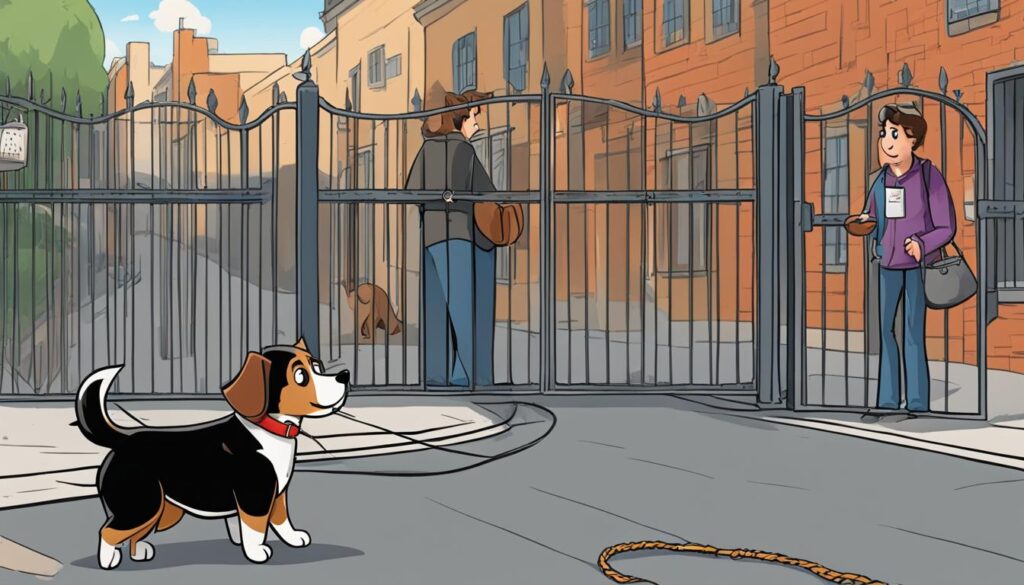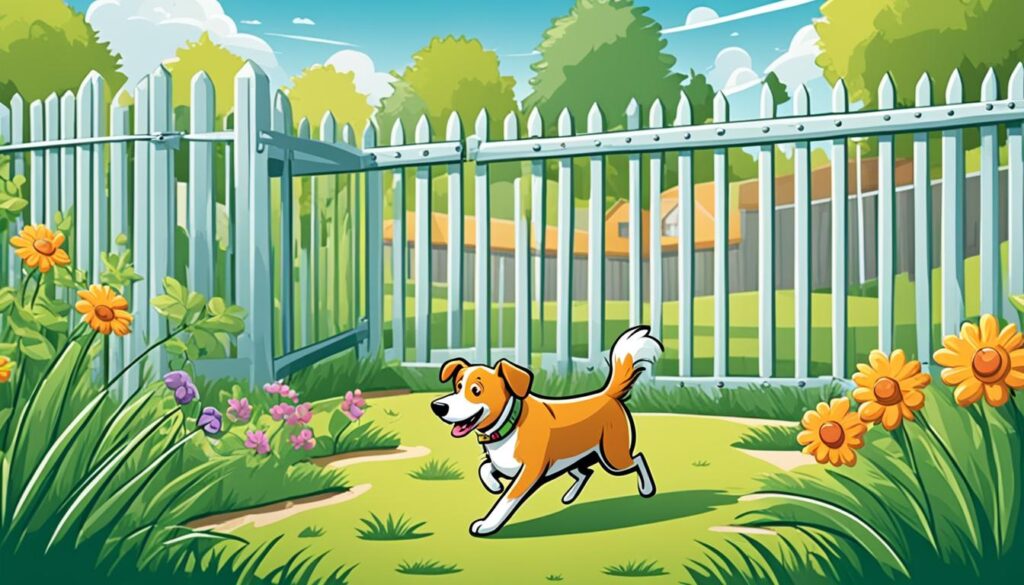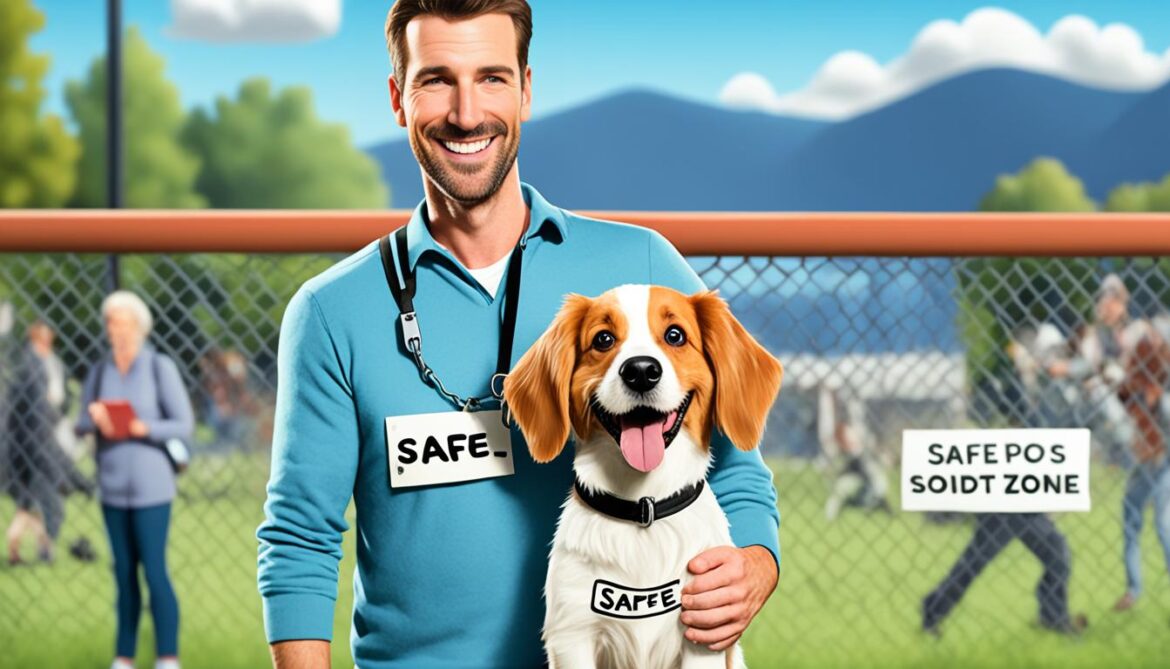As a dog owner, there’s nothing quite as heart-stopping as the moment you realize your beloved companion has escaped. The panicked calls, the frantic searching, the constant worry that they might be in danger – it’s an experience that no pet parent wants to go through. But the good news is that with the right training and precautions, you can prevent your dog from running away and keep them safe by your side.
In this article, we will explore effective strategies on how to train your dog not to run away. By implementing these techniques, you can ensure a safer environment for your furry friend and strengthen the bond between you both. Additionally, we will discuss the importance of setting secure boundaries to prevent your dog from escaping.
Key Takeaways:
- Training your dog not to run away is crucial for their safety.
- Understanding your dog’s behavior and motivations is essential when implementing training techniques.
- Creating a safe and secure environment, such as installing fences or using pet gates, can prevent escape behavior.
- Consistency is key – regular training exercises and reinforcement will help solidify obedience and prevent running away.
- By following the strategies outlined in this article, you can ensure both the safety of your dog and a happier, more secure bond between you both.
Understanding Your Dog’s Behavior
Before delving into effective dog training techniques, it is crucial to gain a deeper understanding of why dogs may exhibit behavior like running away. By comprehending the underlying motivations behind your dog’s actions, you can tailor your training approach to address the root causes. Here, we explore common reasons why dogs may try to escape, such as:
- Curiosity: Dogs are naturally curious creatures and may wander off to explore new scents, sights, or sounds.
- Fear: Dogs may run away when they feel frightened or threatened by certain situations or stimuli.
- Attention-seeking: Some dogs may attempt to escape simply to attract attention or seek companionship.
Gaining insight into your dog’s behavior will allow you to develop a training plan that effectively prevents them from escaping. Let’s now explore some tried and tested dog training techniques that can help you achieve this goal.
Teaching the Recall Command
One of the most important dog training techniques to prevent escape behavior is teaching your dog the recall command. This command enables you to call your dog back to you, ensuring they stay safely by your side. To teach the recall command:
- Find a quiet and distraction-free area to begin training.
- Start with a short leash and call your dog’s name, followed by the recall command, such as “come” or “here.”
- Use positive reinforcement, such as treats or praise, when your dog comes to you.
- Gradually increase the distance and practice in different environments to reinforce the recall command.
Consistency and patience are key when teaching the recall command. Keep training sessions short and enjoyable for your dog, and gradually increase the difficulty level as they become more proficient.
Utilizing Positive Reinforcement
Positive reinforcement is a powerful tool in dog training, including preventing escape behavior. By rewarding desired behaviors, you can encourage your dog to make positive choices and strengthen their bond with you. Here are some tips for utilizing positive reinforcement:
“Reward your dog with treats, praise, or play every time they exhibit good behavior, such as staying within your designated boundaries. This rewards-based approach motivates them to repeat this behavior and actively discourages escape tendencies.”
Remember to be consistent in your training efforts and follow a positive reinforcement approach, avoiding punishment or harsh methods. With patience and persistence, you can effectively train your dog not to run away.

| Benefit | Technique |
|---|---|
| Builds trust and cooperation | Positive reinforcement through treats, praise, or play |
| Improves recall response | Teaching the recall command in different environments |
| Addresses underlying motivations for escape | Understanding your dog’s behavior and tailoring training accordingly |
| Strengthens bond between you and your dog | Consistency in training efforts and positive interactions |
By understanding your dog’s behavior and utilizing positive reinforcement techniques like teaching the recall command, you can effectively prevent and stop escape behavior. Remember, training requires patience, consistency, and a deep understanding of your furry friend’s needs and motivations.
Creating a Safe and Secure Environment
In order to prevent your dog from running away, it’s important to create a safe and secure environment for them. By implementing these tips and strategies, you can significantly reduce the chances of your furry friend escaping.
1. Install Secure Fences
One of the most effective ways to secure your pet’s boundaries is by installing sturdy and secure fences around your yard. Choose fences that are tall enough to prevent your dog from jumping over and ensure that there are no gaps or loose areas that they can squeeze through.
2. Use Pet Gates
If you have indoor areas that you want to keep your dog away from, such as a specific room or staircase, consider using pet gates. These gates are designed to create a physical barrier and prevent your dog from accessing certain areas.
3. Reinforce Existing Boundaries
If you already have a fence or boundary in place, it’s crucial to regularly inspect and reinforce it. Check for any loose panels or gaps that your dog may be able to exploit. Repair or reinforce these areas to ensure that they are secure and escape-proof.
Tip: Secure boundaries are not only beneficial for preventing your dog from running away, but they also provide them with a sense of security and belonging. It’s important for dogs to know their boundaries and feel safe within their environment.
By implementing these measures and creating a safe and secure environment, you can ensure the well-being of your dog and provide them with a space where they can thrive without the risk of escaping.

Continue reading Section 4: Training Exercises and Consistency to learn more about effective techniques to train your dog not to run away.
Training Exercises and Consistency
Consistency plays a crucial role in obedience training for dogs. By maintaining a regular training routine, you can reinforce desired behaviors and prevent your dog from running away. In this section, we will explore various dog training techniques that emphasize positive reinforcement.
Recall Command Training
Teaching your dog the recall command is an essential exercise in preventing escape behavior. Start by practicing in a familiar, distraction-free environment. Call your dog’s name followed by a command such as “come” or “here.” When your dog responds and comes to you, reward them with praise, treats, or both. Gradually increase the distance and add distractions to challenge their obedience skills.
Reinforcing Basic Obedience Training
Building a strong foundation of basic obedience commands is key to preventing escape behavior. Regularly practice commands such as sit, stay, and leave it to reinforce your dog’s understanding of boundaries. Remember to use positive reinforcement, rewarding your dog for correctly following the commands with treats, praise, and affection.
Incorporating Interactive Play
Engaging in interactive play with your dog not only strengthens your bond but also helps redirect their attention away from escaping. Choose interactive toys or games that require mental and physical engagement, such as puzzle toys or hide-and-seek. By providing them with mental stimulation, you are less likely to have a bored dog seeking escape opportunities.
Remember, successful dog training techniques rely on positive reinforcement rather than punishment. When your dog displays the desired behavior of staying within the boundaries, reward them with treats, praise, and affection. Consistency and patience are key as you work together to reinforce obedience and prevent your dog from running away.
By incorporating these training exercises and maintaining consistency in your efforts, you can effectively train your dog not to run away. Positive reinforcement dog training methods create a harmonious environment that fosters trust and strengthens the bond between you and your furry companion.
Conclusion
By implementing the techniques discussed in this article, you can effectively train your dog not to run away and provide a safe environment for your furry companion. Understanding your dog’s behavior is crucial in addressing this issue. Take the time to identify the reasons behind their urge to escape, whether it’s curiosity, fear, or attention-seeking. By tailoring your training approach to address these motivations, you can better prevent your dog from running away.
Creating a safe and secure environment is another essential aspect of preventing your dog from escaping. Install appropriate fencing, use pet gates, or reinforce boundaries to keep your dog within the designated areas. Consistency is key in dog training, so make sure to follow through with the exercises and techniques discussed. Positive reinforcement training methods, such as rewarding good behavior and using treats or praise, are highly effective in encouraging your dog to stay close.
Remember, training your dog not to run away is not only about their safety but also about developing a stronger bond between you and your furry friend. By investing time and effort into their training, you are fostering a deeper connection and ensuring that they feel secure and loved. With patience, consistency, and positive reinforcement, you can raise a well-behaved dog who stays by your side, no matter what.
